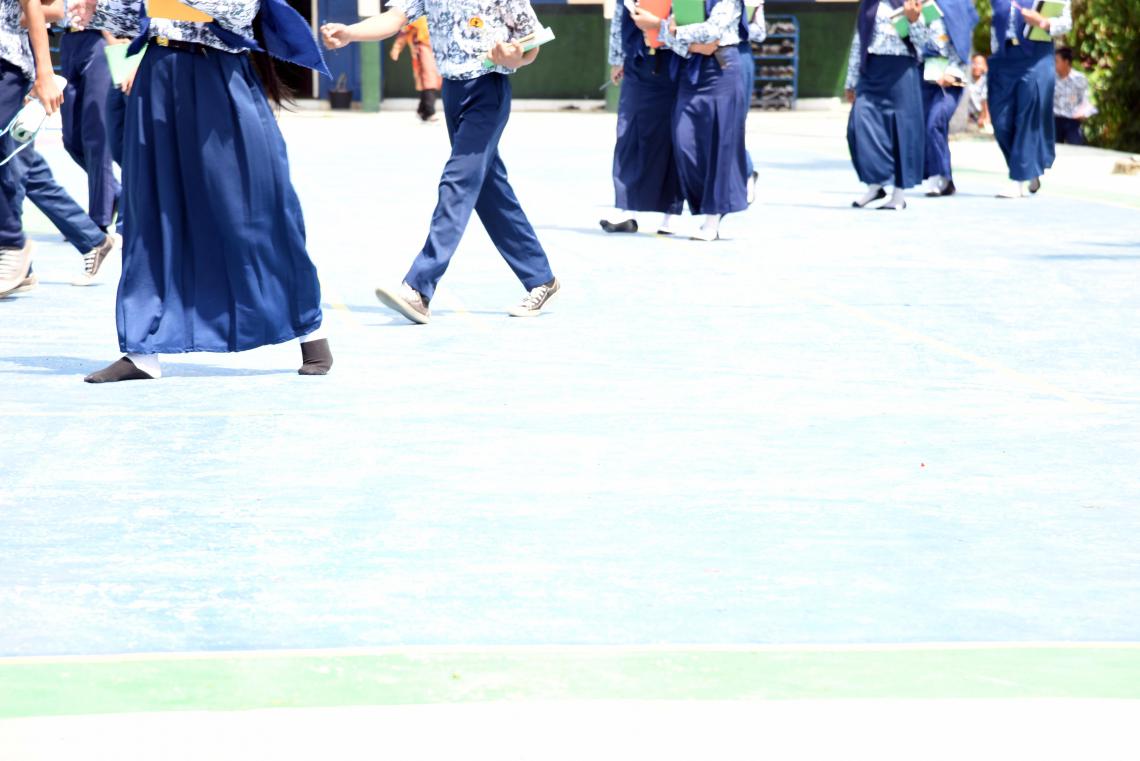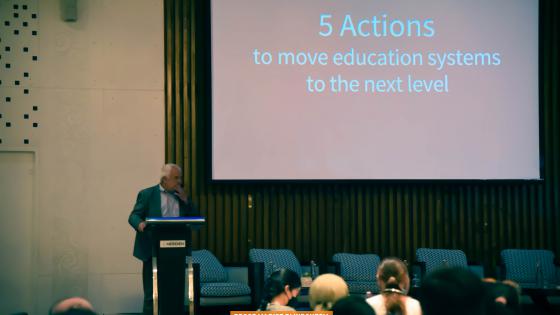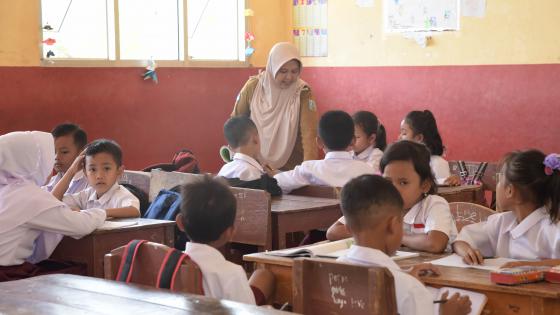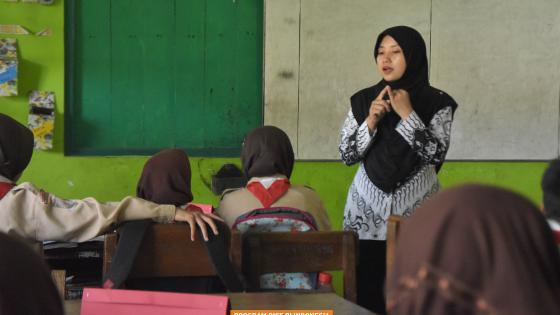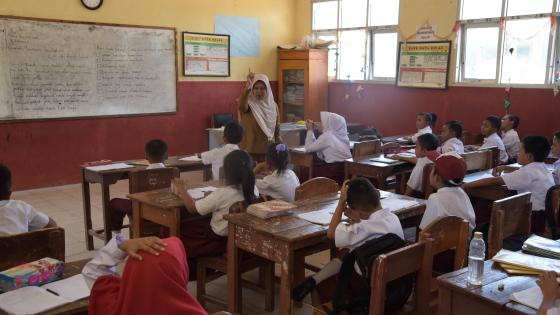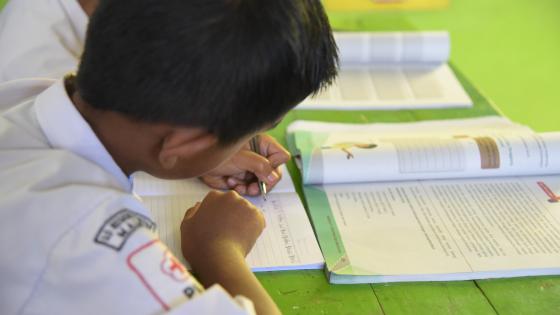Photo illustration: Novita Eka Syaputri
Basic education in Indonesia is compulsory and includes six years of primary school (Grade 1-6) and 3 years of junior secondary school (Grade 7-9). In the past decades, Indonesia has achieved huge progress in improving access to basic education. As of 2019, net enrolment rates were 98 percent at the primary level and 79 percent at the junior secondary level. This achievement can be largely attributed to government efforts to provide free education in public schools. Nevertheless, Indonesia still faces the challenge of improving equity in access to quality education, specifically at the junior secondary school level.
The school admission system results in inequitable access to free quality public junior secondary schools
In Indonesia, public junior secondary schools generally perform better than private schools. Due to better resources, more well-trained teachers, and the selection of better performing students, public junior secondary school graduates score higher on the Grade 9 national exam than their privately schooled peers.
However, the free quality public junior secondary schools only serve about 70 percent of students nationally. In the past, admission to public junior secondary schools was based on student performance on the Grade 6 exam, set by the province and administered in all public and private primary schools. Students who were not accepted to public school had to attend private school (although private school fees were partially subsidised by the government in several regions).
Under this system, students with a high Grade 6 exam score, referred to as high-performing students in this blog, were admitted to the public schools. These students were more likely to come from wealthy families. Meanwhile, the students with a low Grade 6 exam score (or low-performing students), many of whom came from poor families, generally had to pay to attend low-quality private schools. While high-quality private schools do exist, their fees are high making them unaffordable for poor students. As a result, the previous admission system led to inequity in access to quality education, putting poor and low-performing students at a particular disadvantage.
Changing the school admission system to address the inequity issue
Recognising that the admission system was denying the poor and low-performing students access to high-quality and free education, the Indonesian Ministry of Education and Culture changed the admission system in 2017 for public junior secondary schools from one that was entirely based on the Grade 6 examination scores, to one that prioritises the student’s house-to-school distance. This new admission policy is colloquially referred to as the ‘school zoning policy’. The policy allows the students that live near public schools to enroll in them. The central government expected this new system to promote equal access to quality education. While the central government released the school zoning policy in 2017, Indonesia’s decentralisation system gives local governments broad latitude to decide on how to implement the policy in their region.
Moving to a more equitable admission system: a case study of Yogyakarta
We examine the effect of this policy change on the student composition in junior secondary schools in one city – Yogyakarta – that has some of the highest-performing schools in the country. The city has 16 public junior secondary schools that cover about 60 percent of all junior secondary school seats in the city. Yogyakarta implemented the school zoning policy for public junior secondary school admissions in 2018.
Before the school zoning policy was enacted, all seats in the public schools were allocated based on Grade 6 exam scores. For 75 percent of those seats, there was no consideration of students’ economic background. This policy extended to students in Yogyakarta’s suburbs, such that high-performing students from outside of Yogyakarta City could attend public junior secondary schools in the city. The remaining 25 percent of seats were reserved for students from poor families, but seats were still allocated according to test scores such that the highest-scoring students among those receiving social benefits were admitted (see table below).
When the school zoning policy was implemented in 2018, 75 percent of the seats were reserved for students who lived closest to the school. Meanwhile, only 20 percent of the seats were designated for students to be admitted based on their Grade 6 exam scores. The remaining 5 percent was for transferred students that moved to Yogyakarta due to natural disasters in their place of origin or their parent’s job assignment to Yogyakarta.
| Admission Selection Criteria (all students were ranked by Grade 6 exam score) |
Percent of Students |
|---|---|
| From Yogyakarta | 55 |
| From outside of Yogyakarta | 20 |
| Poor and from Yogyakarta | 25 |
| Admission Selection Criteria (all students were ranked by Grade 6 exam score) |
Percent of Students |
|---|---|
| Proximity to School - from Yogyakarta | 75 |
| Grade 6 Exam Score - from Yogyakarta | 15 |
| Grade 6 Exam Score - from outside of Yogyakarta | 5 |
| Transferred from outside of Yogyakarta | 5 |
Students applied for public junior secondary schools online. In 2018, students chose the admission selection criterion category that applied to them and listed the 16 public schools in the order of their preference. They could choose to list less than 16 public schools on their preference list. If they chose to list only three schools, for instance, they would only be considered for these three schools. The selection process aimed to allocate the students efficiently by using the deferred acceptance mechanism. The school selection process in 2018 was carried out as depicted in the figure below.
Figure 1

Students could apply through two stages: one where selection was based on Grade 6 exam scores and one based on the proximity of their house to the schools. In the first stage, the deferred acceptance mechanism ranked students according to their Grade 6 exam score and the students’ stated school preference. If a school was in high demand, the seats were filled with the highest-scoring students. At this point, the selected students did not have a confirmed seat yet. The students that were rejected from their first school preference were assigned to their second school preference. The mechanism ranked them together with the students that were selected based on their first school preference and filled the seats again with the highest-scoring students. This continued until all seats of the schools that students applied to were filled. Simultaneously, transferred students from outside of Yogyakarta were selected based on the local government’s discretion using information on the students’ transfer documents (not shown in the above figure).
The result of the first stage was published before the selection process of the second stage started, so students from Yogyakarta who were rejected in the first stage based on test scores could join the second stage of the selection process along with the students who applied for the second stage directly. Note that the rejected students from the first stage could change their school preference list in their application for the second stage. The system then used the same deferred acceptance mechanism as in the first stage to allocate students to a public school of their preference, but now ranking the students based on their house-to-school distance and thus selecting the closest students.
Note that students did not have to apply to the school that is closest to their house in the second stage, even though they had the highest chance of being admitted to that school. If they preferred other schools over their neighbourhood school, they could indicate that on their school preference list. However, leaving the neighbourhood public school off the list would increase the risk of having to apply to a private school.
In fact, many students did not prefer to go to their neighbourhood school. Of the students enrolled in public schools through the second stage of the admission selection process, 76 percent of the students enrolled in their first school preference but only 23 percent enrolled in the closest schools to their house. Transport time and cost in the city are low and thus had little effect on students’ and parents’ school preference. The students who are not enrolled in their closest school are still less than a kilometre away from their school, on average.
The school zoning policy gave many low-performing and poor students access to the public schools
The zoning policy also improved access for poor students to public schools. Before the policy, public school students had an average asset index of 0.09 standard deviations lower than students in the private schools. This is due to the fact that many wealthy students attended expensive high quality private schools in Yogyakarta. However, after the implementation of the zoning policy, the average asset index of the students in public schools was 0.36 standard deviations lower than that of the private schools, indicating that more poor students entered the public schools.
The following figure shows that junior secondary schools became much more equitable due to the zoning policy. Prior to the zoning policy, less than 30 percent of students in the public schools scored below the median Grade 6 exam score, while 80 percent of students in the private schools did. After the zoning policy, about 50 percent of students in the public schools scored below the median, while 60 percent of students in the private schools did. The cumulative distributions after the implementation of the zoning policy are almost aligned with the 45 degree diagonal, which represents a perfectly equal distribution. It shows that the students enrolled in public schools through the second stage were a representative sample of all the Grade 6 exam score takers.
Figure 2

Access to public schools mainly improved for the 40 percent lowest scoring students on the Grade 6 exam, as shown by the next figure. Only 29 percent of students in the bottom 40 percent enrolled in public school before the zoning policy, while 66 percent enrolled after implementation of the zoning policy. This means that the probability of enrolling in a public school more than doubled for this group of students. For students in the lowest decile of the Grade 6 exam score, the probability of enrolling in a public school was as much as 8 times higher due to the zoning policy. It might be surprising that there were students with Grade 6 exam scores among the bottom deciles that enrolled in the public schools prior the zoning policy, despite the selection on exam scores. These students applied to the admission selection criteria specifically for poor families (as explained in the first table).
Note that the figure only includes students from Yogyakarta and that the fraction of these students that attended public schools increased by 6 percentage points after implementation of the zoning policy. These seats were allocated to students from outside Yogyakarta before, while they became available to students from Yogyakarta due to the zoning policy.
Figure 3

Despite the success of the zoning policy in improving access to public schools in general, our second blog reveals that the poor and low performing students still did not go to the best quality public schools that they could attend. The second blog further explores the reasons that underlie such phenomena.
This blog was originally posted on RISE Programme website and has been cross-posted with permission.

